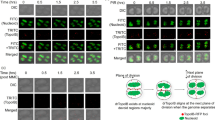Abstract
The conclusion based on transmission electron microscopy, “the tightly packed ring-like nucleoid of the Deinococcus radiodurans R1 is a key to radioresistance”, has instigated lots of debates. In this study, according to the previous research of Pprl’s crucial role in radioresistance of D. radiodurans, we have attempted to examine and compare the nucleoid morphology differences among wild-type D. radiodurans R1 strain, pprf function-deficient mutant (YR1), and pprl function-complementary strains (YR1001, YR1002, and YR1004) before and after exposure to ionizing irradiation. Fluorescence microscopy images indicate: (1) the majority of nucleoid structures in radioresistant strain R1 cells exhibit the tightly packed ring-like morphology, while the pprl function-deficient mutant YR1 cells carrying predominate ring-like structure represent high sensitivity to irradiation; (2) as an extreme radioresistant strain similar to wild-type R1, pprl completely function-complementary strain YR1001 almost displays the loose and irregular nucleoid morphologies. On the other hand, another radioresistant pprl partly function-complementary strain YR1002’s nucleiods exhibit about 60% ring-like structure; (3) a Pprl C-terminal deletion strain YR1004 consisting of approximately 60% of ring-like nucleoid is very sensitive to radiation. Therefore, our present experiments do not support the conclusion that the ring-like nucleoid of D. radiodurans does play a key role in radioresistance.
Similar content being viewed by others
References
Battista J R, Earl A M, Park M J. Why is Deinococcus radiodurans so resistant to ionizing radiation? Trends Microbiol, 1999, 7: 362–365
Cox M M, Battista J R. Deinococcus radiodurans—The consummate survivor. Nat Rev Microbiol, 2005, 3: 882–892
Narumi I. Unlocking radiation resistance mechanisms: Still a long way to go. Trends Microbiol, 2003, 11: 422–425
Makarova K S, Aravind L, Wolf Y I, et al. Genome of the extremely radiation-resistant bacterium Deinococcus radiodurans viewed from the perspective of comparative genomics. Microbiol Mol Biol Rev, 2001, 65: 44–79
Hua Y, Narumi I, Gao G, et al. PprI: A general switch responsible for extreme radioresistance of Deinococcus radiodurans. Biochem Biophys Res Commun, 2003, 306: 354–360
Narumi I, Satoh K, Cui S, et al. PprA: A novel protein from Deinococcus radiodurans that stimulates DNA ligation. Mol Microbiol, 2004, 54: 278–285
Harris D R, Tanaka M, Saveliev S V, et al. Preserving genome integrity: The D drA protein of Deinococcus radiodurans R1. PLoS Biol, 2004, 2: e304.
Levin-Zaidman S, Englander J, Shimoni E, et al. Ringlike structure of the Deinococcus radiodurans genome: A key to radioresistance? Science, 2003, 299: 254–256
Frenkiel-Krispin D, Minsky A. Nucleoid organization and the maintenance of DNA integrity in E. coli, B. subtilis and D. radiodurans. J Struct Biol, 2006, 156: 311–319
Minsky A, Shimoni E, Englander J. Ring-like nucleoids and DNA repair through error-free nonhomologous end joining in Deinococcus radiodurans. J Bacteriol, 2006, 188: 6047–6051
Englander J, Klein E, Brumfeld V, et al. DNA toroids: Framework for DNA repair in Deinococcus radiodurans and in germinating bacterial spores. J Bacteriol, 2004, 186: 5973–5977
Zimmerman J M, Battista J R. A ring-like nucleoid is not necessary for radioresistance in the Deinococcaceae. BMC Microbiol, 2005, 5: 17
Eltsov M, Dubochet J. Fine structure of the Deinococcus radiodurans nucleoid revealed by cryoelectron microscopy of vitreous sections. J Bacteriol, 2005, 187: 8047–8054
Eltsov M, Dubochet J. Study of the Deinococcus radiodurans nucleoid by cryoelectron microscopy of vitreous sections: Supplementary comments. J Bacteriol, 2006, 188: 6053–6058.
Eltsov M, Dubochet J. Rebuttal: Ring-like nucleoids and DNA repair in Deinococcus radiodurans. J Bacteriol, 2006, 188: 6052
Meima R, Rothfuss H M, Gewin L, et al. Promoter cloning in the radioresistant bacterium Deinococcus radiodurans. J Bacteriol, 2001, 183: 3169–3175
White O, Eisen J A, Heidelberg J F, et al. Genome sequence of the radioresistant bacterium Deinococcus radiodurans R1. Science, 1999, 286: 1571–1577
Ghosal D, Omelchenko M V, Gaidamakova E K, et al. How radiation kills cells: Survival of Deinococcus radiodurans and Shewanella oneidensis under oxidative stress. FEMS Microbiol Rev, 2005, 29: 361–375
Tanaka M, Earl A M, Howell H A, et al. Analysis of Deinococcus radiodurans’s transcriptional response to ionizing radiation and desiccation reveals novel proteins that contribute to extreme radioresistance. Genetics, 2004, 168: 21–33
Daly M J, Gaidamakova E K, Matrosova V Y, et al. Accumulation of Mn(II) in Deinococcus radiodurans facilitates gamma-radiation resistance. Science, 2004, 306: 1025–1028
Battista J R, Cox M M, Daly M J, et al. The structure of D. radiodurans. Science, 2003, 302: 567–568
Minsky A, Shimoni E, Englander J. Rebuttal: Study of the Deinococcus radiodurans nucleoid. J Bacteriol, 2006, 188: 6059
Gao G, Lu H, Huang L, et al. Construction of DNA damage response gene pprI function-deficient and function-complementary mutants in Deinococcus radiodurans. Chin Sci Bull, 2005, 50: 311–316
Liu Y, Zhou J, Omelchenko M V, et al. Transcriptome dynamics of Deinococcus radiodurans recovering from ionizing radiation. Proc Natl Acad Sci USA, 2003, 100: 4191–4196
Author information
Authors and Affiliations
Corresponding author
Additional information
Supported by the National Basic Research Program of China (Grant No. 2004CB19604), the National Natural Science Foundation of China (Grant No. 30330020), and the National Science fund for Distinguished Young Scholars (Grant No. 30425038)
Rights and permissions
About this article
Cite this article
Gao, G., Lu, H., Yin, L. et al. Ring-like nucleoid does not play a key role in radioresistance of Deinococcus radiodurans . SCI CHINA SER C 50, 525–529 (2007). https://doi.org/10.1007/s11427-007-0061-x
Received:
Accepted:
Issue Date:
DOI: https://doi.org/10.1007/s11427-007-0061-x




